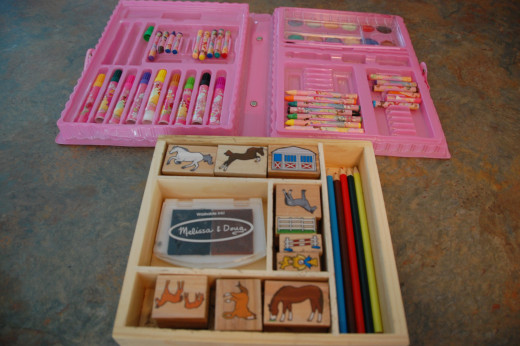How to Teach Art to Kids



Teaching art to kids is probably the best job I have ever done. I have taught art to kids from Pre-Kindergarten through senior year of high school. I will be getting back into the classroom this year at a small K-5 school in the Art Room. I cannot wait! When I had a gift store a few years ago, I actually taught private art lessons to some first graders and an adult after hours. Informally, I have been babysitting and doing art projects with the kids I have been siting for over the past few years.
When I do a project at home with the kids, it is generally based around the season or holiday that is coming up. Many times, I make coloring pages for the kids. We use stickers, markers, crayons, torn paper, stamps and glitter glue to color the pages in. We also use watercolor, coloring pencils or pastels. You need to have a variety of papers for the kids to work with such as construction paper, watercolor paper for painting and maybe even some canvas pieces if you use acrylic paint. My kids have a few different art supply sets that we share with everyone. I don't usually use acrylics with very young kids, but I have used tempera paints, which wash up very easily. I have done acrylic painting with my own children, but it can get messy so I do not use it when babysitting. Kids art supply sets can be found at many different types of stores; craft stores, sewing stores, toy stores and even some department stores offer art supply sets in various forms. We usually get at least one new art supply set per year. The kids have gotten them as birthday and Christmas presents in the past.
Teaching in the classroom deserves a more formal approach than at home. I generally have a story that goes along with the project that we will be doing for the lesson. One of my favorite story projects is done with kindergartners and entails reading "Harold and the Purple Crayon". The kids are then given purple crayons and a large sheet of construction paper and asked to draw where they would like to go and what they imagine like Harold does. This is always a hit with the students. Most of the time I'll demonstrate the project first for the students so they see how to use the materials and basically what I expect from them. When I taught private lessons, I started with simple drawing and shading of shapes. After using directed light on shapes and learning how shadows work to make things look three-dimensional, I have them try their hand at drawing a still life.
Once we have worked with black and white pencil drawing, we progress on to color study and the color wheel. This way the kids learn how to mix different colors and learn that all colors are made from the three primary colors; red, yellow and blue. Then I teach the kids about tinting and shading. This is done either by adding various amounts of white (tinting) or various amounts of black (shading) to the color. The kids are always amazed at what you can do with color. We do several art pieces using different types of color pencils, pastels, oil pastels and paints. We use as many different methods of making art as we can, exploring in art is a wonderful way for a child to learn. We move into three-dimensional art as the class progresses, but that is information for another hub.
One of the biggest things to remember when teaching art to kids is to make them feel good about their art. It is a great place for kids to express themselves and you do not want to give negative vibes about what they have accomplished. You can help them along the way to improve their art. Being supportive of their art and guiding their work is an incredible experience as a teacher. I have never felt as good doing a job as I did when the students that hated art in the beginning of the year really got into it and were proud of their accomplishments by the end of the year. It was a great feeling!









